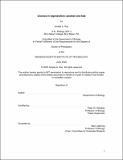| dc.contributor.advisor | Peter W. Reddien. | en_US |
| dc.contributor.author | Raz, Amelie A. | en_US |
| dc.contributor.other | Massachusetts Institute of Technology. Department of Biology. | en_US |
| dc.date.accessioned | 2020-09-15T21:54:21Z | |
| dc.date.available | 2020-09-15T21:54:21Z | |
| dc.date.copyright | 2020 | en_US |
| dc.date.issued | 2020 | en_US |
| dc.identifier.uri | https://hdl.handle.net/1721.1/127370 | |
| dc.description | Thesis: Ph. D., Massachusetts Institute of Technology, Department of Biology, May, 2020 | en_US |
| dc.description | Cataloged from the official PDF of thesis. Page 195 blank. | en_US |
| dc.description | Includes bibliographical references. | en_US |
| dc.description.abstract | Positional information is required for animal regeneration, yet how it is harbored in adult tissues is poorly understood. In planarians, positional control genes (PCGs) control regeneration outcomes and are regionally expressed predominately in the musculature. Acoels are early diverging bilaterally symmetric animals, having separated from other bilaterians >550 million years ago. We find that PCGs in the acoel Hofstenia miamia are expressed together and specifically in a primary differentiated cell type: muscle. The vast majority of Hofstenia muscle cells in regions tested express PCGs, suggesting positional information is a major feature of muscle. PCG expression domains are dynamic in muscle after injury, consistent with known PCG roles in guiding regeneration. | en_US |
| dc.description.abstract | These data demonstrate an instructive positional role for Hofstenia muscle and this similarity with planarians suggests mesodermal muscle originated at the base of the Bilateria not only for contraction, but also as the source of positional information guiding regeneration. Planarians rely on a population of adult stem cells to perform whole-body regeneration. Previous work has shown that at least some of these stem cells, known as neoblasts, are individually pluripotent. The neoblast compartment is also highly heterogeneous, with many neoblast subpopulations, called specialized neoblasts, having different specified fates. These fates are specified through expression of fate-specific transcription factors (FSTFs), and inhibition of these factors can lead to precise ablation of a given lineage. Interestingly, fate specification of specialized neoblasts for the epidermis (zeta-neoblast) occurs during S phase, and commitment to this fate occurs in one cell cycle. | en_US |
| dc.description.abstract | We demonstrate here that whereas FSTF expression is common among neoblasts in S, G2, and M cell cycle phases, neoblasts in G1 phase only rarely express FSTFs, suggesting that neoblasts might exist in a common, unspecialized state during G1. We also demonstrate that these unspecialized G1 neoblasts can arise from the division of a specialized neoblast, suggesting that specialized neoblasts retain pluripotent potential. Examination of expanding colonies of neoblasts show that early colonies can completely lack cells expressing markers of all known specialized neoblast classes, consistent with a model in which multiple-to-all neoblast classes can generate clonogenic, pluripotent cells. To further test this hypothesis, we performed single-cell transplants to assay the functional pluripotency of specialized neoblasts, comparing the frequency of colony formation by transplanted neoblasts to the rate of unspecialized neoblasts from the same cohort of cells. | en_US |
| dc.description.abstract | We found that neither neoblasts of known specialization state nor unspecialized neoblasts alone can explain the frequency of colony formation by single-cell transplants. Together these findings suggest that specialization through expression of fate-specific markers does not necessitate fate commitment, and that all neoblasts might have clonogenic potential. | en_US |
| dc.description.statementofresponsibility | by Amelie A. Raz. | en_US |
| dc.format.extent | 195 pages | en_US |
| dc.language.iso | eng | en_US |
| dc.publisher | Massachusetts Institute of Technology | en_US |
| dc.rights | MIT theses may be protected by copyright. Please reuse MIT thesis content according to the MIT Libraries Permissions Policy, which is available through the URL provided. | en_US |
| dc.rights.uri | http://dspace.mit.edu/handle/1721.1/7582 | en_US |
| dc.subject | Biology. | en_US |
| dc.title | Choices in regeneration: position and fate | en_US |
| dc.type | Thesis | en_US |
| dc.description.degree | Ph. D. | en_US |
| dc.contributor.department | Massachusetts Institute of Technology. Department of Biology | en_US |
| dc.identifier.oclc | 1192498030 | en_US |
| dc.description.collection | Ph.D. Massachusetts Institute of Technology, Department of Biology | en_US |
| dspace.imported | 2020-09-15T21:54:21Z | en_US |
| mit.thesis.degree | Doctoral | en_US |
| mit.thesis.department | Bio | en_US |
